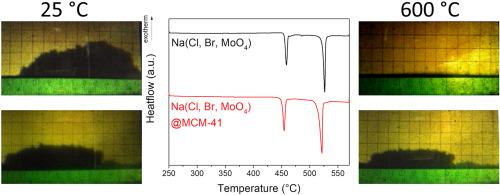当前位置:
X-MOL 学术
›
Sol. Energy Mater. Sol. Cells
›
论文详情
Our official English website, www.x-mol.net, welcomes your
feedback! (Note: you will need to create a separate account there.)
High temperature shape – Stabilized phase change materials obtained using mesoporous silica and NaCl – NaBr – Na2MoO4 salt eutectic
Solar Energy Materials and Solar Cells ( IF 6.3 ) Pub Date : 2020-12-01 , DOI: 10.1016/j.solmat.2020.110760 Raul - Augustin Mitran , Daniel Lincu , Simona Ioniţǎ , Mihaela Deaconu , Victor Valentin Jerca , Oana Cǎtǎlina Mocioiu , Daniela Berger , Cristian Matei
Solar Energy Materials and Solar Cells ( IF 6.3 ) Pub Date : 2020-12-01 , DOI: 10.1016/j.solmat.2020.110760 Raul - Augustin Mitran , Daniel Lincu , Simona Ioniţǎ , Mihaela Deaconu , Victor Valentin Jerca , Oana Cǎtǎlina Mocioiu , Daniela Berger , Cristian Matei

|
Abstract Thermal energy storage at temperatures above 400 °C is critical for efficient industrial processes and continuous solar thermal power generation. Phase change materials (PCMs) can be used for both latent heat storage and improved conversion efficiencies, but their use has been prevented by the large, 5–25 % change in molar volume. Herein, shape-stabilized PCMs are prepared using 20% wt. mesoporous silica matrices and NaCl–NaBr–Na2MoO4 salt eutectic. The pristine salt mixture has a total enthalpy of 216 Jg-1 divided into a solid-solid transition at 455 °C and solid – liquid transition at 522 °C. Six mesoporous silica materials of the MCM-41 (Mobil Composition of Matter No. 41), SBA-15 (Santa Barbara Amorphous) and mesocellular foam types were investigated as potential matrices for high temperature, shape-stabilized PCMs. All resulting composites have good thermal stability up to 650 °C. High – temperature optical microscopy shows that all samples retain their macroscopic solid shape above the salt melting point. Electron microscopy revealed a good dispersion of the silica matrix inside the molten salt phases. Both MCM-41 and SBA-15-type matrices yield PCMs with high total heat of fusion values between 169 – 178 Jg-1, in accordance to the 80% wt. salt fraction. The melting point is decreased with 5–10 °C for all composite materials, indicating nanoconfinement effects of the interparticle salt phase. This work therefore provides a new strategy for obtaining shape-stabilized materials useful for high – temperature heat storage.
中文翻译:

高温形状 – 使用介孔二氧化硅和 NaCl – NaBr – Na2MoO4 盐共晶获得的稳定相变材料
摘要 400 °C 以上的热能储存对于高效的工业过程和连续的太阳能热发电至关重要。相变材料 (PCM) 可用于潜热储存和提高转化效率,但由于摩尔体积 5-25% 的大变化而无法使用。在此,形状稳定的 PCM 是使用 20% wt 制备的。介孔二氧化硅基质和 NaCl-NaBr-Na2MoO4 盐共晶。原始盐混合物的总焓为 216 Jg-1,分为 455 °C 的固-固转变和 522 °C 的固-液转变。研究了 MCM-41(Mobil Composition of Matter No. 41)、SBA-15(Santa Barbara Amorphous)和中孔泡沫类型的六种介孔二氧化硅材料作为高温、形状稳定的 PCM 的潜在基质。所有所得复合材料在高达 650 °C 时都具有良好的热稳定性。高温光学显微镜显示所有样品在盐熔点以上保持其宏观固体形状。电子显微镜显示二氧化硅基质在熔盐相内具有良好的分散性。根据 80% wt,MCM-41 和 SBA-15 型矩阵产生的 PCM 具有 169 – 178 Jg-1 之间的高总熔化热值。盐分。所有复合材料的熔点随着 5-10°C 的降低而降低,表明颗粒间盐相的纳米限制效应。因此,这项工作为获得可用于高温蓄热的形状稳定材料提供了一种新策略。高温光学显微镜显示所有样品在盐熔点以上保持其宏观固体形状。电子显微镜显示二氧化硅基质在熔盐相内具有良好的分散性。根据 80% wt,MCM-41 和 SBA-15 型矩阵产生的 PCM 具有 169 – 178 Jg-1 之间的高总熔化热值。盐分。所有复合材料的熔点随着 5-10°C 的降低而降低,表明颗粒间盐相的纳米限制效应。因此,这项工作为获得可用于高温蓄热的形状稳定材料提供了一种新策略。高温光学显微镜显示所有样品在盐熔点以上保持其宏观固体形状。电子显微镜显示二氧化硅基质在熔盐相内具有良好的分散性。根据 80% wt,MCM-41 和 SBA-15 型矩阵产生的 PCM 具有 169 – 178 Jg-1 之间的高总熔化热值。盐分。所有复合材料的熔点随着 5-10°C 的降低而降低,表明颗粒间盐相的纳米限制效应。因此,这项工作为获得可用于高温蓄热的形状稳定材料提供了一种新策略。根据 80% wt,MCM-41 和 SBA-15 型矩阵产生的 PCM 具有 169 – 178 Jg-1 之间的高总熔化热值。盐分。所有复合材料的熔点随着 5-10°C 的降低而降低,表明颗粒间盐相的纳米限制效应。因此,这项工作为获得可用于高温蓄热的形状稳定材料提供了一种新策略。根据 80% wt,MCM-41 和 SBA-15 型矩阵产生的 PCM 具有 169 – 178 Jg-1 之间的高总熔化热值。盐分。所有复合材料的熔点随着 5-10°C 的降低而降低,表明颗粒间盐相的纳米限制效应。因此,这项工作为获得可用于高温蓄热的形状稳定材料提供了一种新策略。
更新日期:2020-12-01
中文翻译:

高温形状 – 使用介孔二氧化硅和 NaCl – NaBr – Na2MoO4 盐共晶获得的稳定相变材料
摘要 400 °C 以上的热能储存对于高效的工业过程和连续的太阳能热发电至关重要。相变材料 (PCM) 可用于潜热储存和提高转化效率,但由于摩尔体积 5-25% 的大变化而无法使用。在此,形状稳定的 PCM 是使用 20% wt 制备的。介孔二氧化硅基质和 NaCl-NaBr-Na2MoO4 盐共晶。原始盐混合物的总焓为 216 Jg-1,分为 455 °C 的固-固转变和 522 °C 的固-液转变。研究了 MCM-41(Mobil Composition of Matter No. 41)、SBA-15(Santa Barbara Amorphous)和中孔泡沫类型的六种介孔二氧化硅材料作为高温、形状稳定的 PCM 的潜在基质。所有所得复合材料在高达 650 °C 时都具有良好的热稳定性。高温光学显微镜显示所有样品在盐熔点以上保持其宏观固体形状。电子显微镜显示二氧化硅基质在熔盐相内具有良好的分散性。根据 80% wt,MCM-41 和 SBA-15 型矩阵产生的 PCM 具有 169 – 178 Jg-1 之间的高总熔化热值。盐分。所有复合材料的熔点随着 5-10°C 的降低而降低,表明颗粒间盐相的纳米限制效应。因此,这项工作为获得可用于高温蓄热的形状稳定材料提供了一种新策略。高温光学显微镜显示所有样品在盐熔点以上保持其宏观固体形状。电子显微镜显示二氧化硅基质在熔盐相内具有良好的分散性。根据 80% wt,MCM-41 和 SBA-15 型矩阵产生的 PCM 具有 169 – 178 Jg-1 之间的高总熔化热值。盐分。所有复合材料的熔点随着 5-10°C 的降低而降低,表明颗粒间盐相的纳米限制效应。因此,这项工作为获得可用于高温蓄热的形状稳定材料提供了一种新策略。高温光学显微镜显示所有样品在盐熔点以上保持其宏观固体形状。电子显微镜显示二氧化硅基质在熔盐相内具有良好的分散性。根据 80% wt,MCM-41 和 SBA-15 型矩阵产生的 PCM 具有 169 – 178 Jg-1 之间的高总熔化热值。盐分。所有复合材料的熔点随着 5-10°C 的降低而降低,表明颗粒间盐相的纳米限制效应。因此,这项工作为获得可用于高温蓄热的形状稳定材料提供了一种新策略。根据 80% wt,MCM-41 和 SBA-15 型矩阵产生的 PCM 具有 169 – 178 Jg-1 之间的高总熔化热值。盐分。所有复合材料的熔点随着 5-10°C 的降低而降低,表明颗粒间盐相的纳米限制效应。因此,这项工作为获得可用于高温蓄热的形状稳定材料提供了一种新策略。根据 80% wt,MCM-41 和 SBA-15 型矩阵产生的 PCM 具有 169 – 178 Jg-1 之间的高总熔化热值。盐分。所有复合材料的熔点随着 5-10°C 的降低而降低,表明颗粒间盐相的纳米限制效应。因此,这项工作为获得可用于高温蓄热的形状稳定材料提供了一种新策略。











































 京公网安备 11010802027423号
京公网安备 11010802027423号